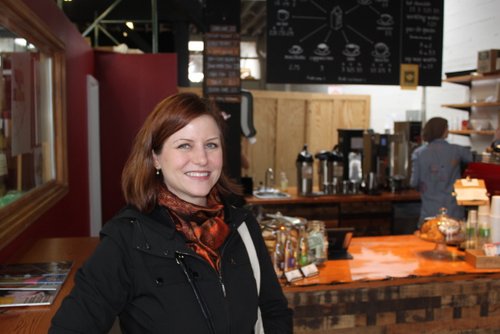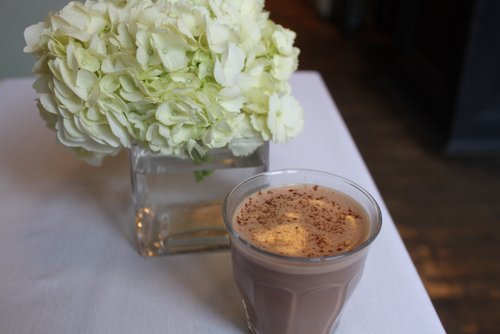When you visit somewhere new for the first time, one of the best ways to get a feel for your new surroundings is to find a local guide. Whether you are looking for museums, restaurants, or other attractions that don’t always make it into the guidebooks (or to the top of the Google search rankings), a good guide can make your experience much better.
The same holds true if you are looking for good coffee. Portland’s reputation for coffee is well-known around the world, yet it can still be a challenge for tourists (or even locals) to choose where to go when they want to explore the city’s coffee scene (granted, one of the challenges is that there are so many options). A new company, Third Wave Coffee Tours, owned and operated by Lora Woodruff, is making it more convenient to find good coffee, whether you are making your first trip to Portland or have lived here all your life.
Woodruff was born in Portland, but she grew up in Walla Walla, beneath the sunny skies of Eastern Washington. After attending college in England, she eventually returned to the Northwest, settling down in Portland. Prior to starting her own company, Woodruff worked as a web developer for Nike and then as a web developer and business analyst for Intel.
Lora decided to take a break from the corporate world when her daughter was born. Though she no longer had to go to the office, she still made it a point to get out of the house every day, and cafés became a favorite destination, especially Public Domain and the downtown Stumptown cafés. An article about coffee in the Oregonian’sA&E section inspired her to learn more about coffee. She visited new cafés, talked to baristas, and took part in cuppings around the city.
While her coffee knowledge and enthusiasm grew, Woodruff realized others might like to learn more too. Sharing Portland with outsiders had always come naturally to her. “I love Portland,” she said. For several years, Lora has volunteered a few hours each week at the Tourist Information office at Pioneer Square, helping point visitors in the right direction. Lora noticed the city had food tours and beer tours, but no one was really offering coffee tours. Sensing an opportunity, Lora reached out to local roasters and cafés to see if they would be interested in collaborating with her. Receiving positive feedback, she put up a website and started advertising. She lead her first coffee tours last fall, and business has been steadily picking up since then.
Stop #2 – Christopher David
After finishing our macchiatos, we headed up to the roof of the Ecotrust building (one of Portland’s best “secret” spots) for some elevated views of the Pearl District, then walked a block down the street to Christopher David Experience Design (CDExD), where co-owner Kevin Nichols was waiting for us. Nichols, who regularly teaches coffee workshops at CDExD, had set up a Chemex of Water Avenue’s El Salvador Las Delicias coffee on the bar. He carefully walked us through every step of the brewing process, adding several tips on how to make better-tasting coffee at home.
Stop #3 - Sisters
Next up was a stop at Sisters Coffee, on Northwest Marshall. Though the place was slammed with people when we walked in, Jen Luecht, the company’s Portland account and communications manager, calmly waited for us amidst the chaos (it was kind of like having our own personal coffee concierge). Leucht had set up two Hario V60s on the pourover bar, and she too walked us through the process of how to use the brewer.
The first coffee she made was the Black Butte Gold, a dark roast blend that is the company’s most popular (interesting, I thought, considering we were in Portland). I kept an open mind, and to be honest, although it was a little smoky at the end, the cup was fairly smooth. It was better than I expected it to be. The second coffee we sipped was a single origin, direct trade Guatemalan coffee from Finca Villaure, located in the Huehuetenango region (Sisters has a nice video about the farm at this link.)
Stop #4 - Barista
Leaving Sisters, we strode up the street to Barista, where we got to share a siphon of Heart’s Colombia Desarollo coffee.
As always, the siphon at Barista was great coffee theater, and our barista, David, explained how the brewer pulled out the coffee’s best characteristics. The coffee was complex and fruity, with sweetness standing out as it cooled. It was clearly a very high quality coffee, and quite a treat, considering I am rarely willing to purchase a whole siphon for myself.
Note the even, rounded dome left after the brew was finished—one visual clue that the brewing went well.
Stop #5 - Sterling
To stay on schedule, we took our coffees to go and left Barista, turning west and walking under I-405 to a little shop called Sterling, one of my personal favorites in Portland. It is always such a pleasant experience to visit the café, which stands out for its combination of style, service and coffee. While there, we drank two different beverages. The first was an espresso of a Kenyan Nyeri coffee. The espresso was rich, syrupy, and savory, with an aftertaste that reminded me of fresh peaches. The second drink was hot chocolate, made from a single origin Bolivian chocolate. The dense, rich chocolate was sweet and creamy, but not overpowering and not too sweet.
Stop #6 (bonus!) – Ken’s Artisan Bakery
After Sterling, it was time for a snack, also included with the tour. We popped into Ken’s Artisan Bakery for a cannele to go. (In case you didn’t know, a cannele is a tulip-shaped pastry with a sweet crispy crust and a soft, custardy-cakey center. Before Tuesday, I hadn’t even heard of them, which might be the biggest oversight of my first 37 years.)
Stop #7 – Local Roasting
We munched on the canneles as we made our way over to Local Roasting, where owner James Hull and General Manager Abigael Tripp are steadily building the business (open since 2012, Local’s coffees are now available in Food Front, Whole Foods, and a few local restaurants).
Hull prepared us a shakerato (espresso+sugar+ice, shaken up like a cocktail), an interesting drinking experience for anyone. (Since the shakerato is not the most transparent coffee beverage, I plan to return soon to get a better idea of what Local’s coffee is really like).
Stop #8 – Nossa Familia
By this time, the amount of coffee we had consumed was starting to make my head swim, and we still had one more stop. We sauntered back toward the Pearl District, arriving at Nossa Familia just in time for a cupping hosted by Rob Hoos, Nossa Familia’s head roaster. Hoos had ten coffees on the cupping table, nine of which were in the company’s current lineup, and one mystery coffee that was “kind of out there,” as he put it. A few Nossa Familia employees joined us for the cupping, as did a coffee roaster from Russia who happened to be in town visiting his daughter (another example of how coffee is a common thread that brings people together from around the world).
The group spent the next 45 minutes slurping our way around the table and chatting about coffee. My two favorites turned out to be Ernesto’s Blend (single-origin Brazil) and the Nicaraguan coffee from Bayardo Reyes’ farm, from the ‘Extended Familia’ lineup. But what about the mystery coffee?
Mystery solved
Hoos said he often likes to throw a surprise in the cuppings, and in this case, it was an intentionally bad surprise. The mystery coffee was dreadful. It had a metallic, mineral, nearly-gag-inducing taste. I recognized the flavor, having experienced it at more than one (bad) café over the past couple years, though I did not know what caused it. Was it a problem with how the coffee had been processed? Was it overripe when picked or did it have some type of defect?
Hoos explained that there was nothing inherently wrong with the coffee, other than that it was old. The coffee was the first one he had roasted on the company’s (then) new Loring roaster, about two years ago (Hoos had stumbled across a forgotten bag on a storage shelf inside the warehouse). The coffee tasted fine when it was first roasted, but time had not been kind to the beans. The repulsive flavor was a stark example of how coffee can go bad if left for too long. The oils inside the beans, so important to the flavor of the coffee, react with oxygen and create some funky flavors. When I had tasted the flavor previously, it was probably because the café did a poor job of cleaning its equipment. Oil residues in the bean storage containers, grinders, or brewing equipment would build up and then go bad, making coffee made on the same equipment taste bad too. It was a good lesson about the importance of keeping the coffee equipment clean.
Worth checking out
Overall, the tour was both fun and educational. Every café was welcoming and our hosts enjoyed sharing their coffee knowledge with us. For me, one of the nicest things about the tour was that each stop was pre-organized. Lora took care of the ordering, pre-paying for everything (all drinks are included with the tour), so all I had to do was show up and enjoy the drinks.
Although it would be impossible to capture everything Portland has to offer on a single trip, Woodruff’s tours make a great introduction to the Portland coffee scene. The three-hour tour was packed with sights, sounds, and above all, different tastes. Lora was a convivial host, and she did a fine job organizing the tour. Each stop was smooth—everyone welcomed us to their shop, we stayed on schedule, and covered a lot of ground over the three hours. For someone who loves coffee, the tours are a great exposure to some of Portland’s best roasters and cafés. Whether you are in the coffee industry, or are just starting to learn about it, Third Wave Coffee Tours gives you the chance to learn something new.
Just remember to pace yourself. With so many stops, the caffeine adds up!
Vitals
Website: www.thirdwavecoffeetours.com
Options: Third Wave Coffee Tours currently offers four tours each week that explore different parts of the city, the Northwest/Pearl District (held every Tuesday), Downtown (Wednesdays), Eastside (Friday), and the Streetcar Tour (a Sunday morning tour that starts downtown, passes through the Pearl and loops around to the Eastside).
Etc.: Customized special tours are also available, if you contact Woodruff in advance.
Time: ~3 hours
Walking Distance: ~2.1 miles for the NW/Pearl tour (others vary)
Cost: $40
*Note: I did not pay for the tour, nor am I getting paid to write about it. None of the links are affiliate links.










